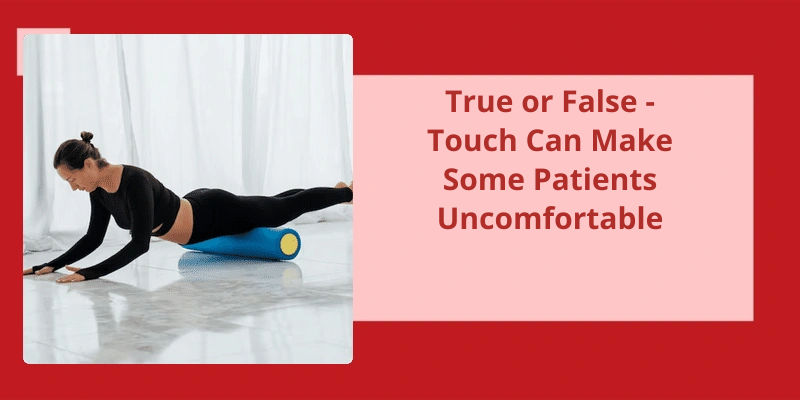As healthcare professionals, doctors and nurses must navigate an array of complex situations. One such situation involves the use of touch during patient care. While touch can be an important part of physical exams and medical procedures, it can also elicit discomfort in some patients. In some cases, touch may not be appropriate altogether, potentially exacerbating existing discomfort. This is especially true in cases where gender dynamics are at play, as touch from a male doctor may be particularly uncomfortable for female patients.
What Is the Power of Touch in Healthcare?
As humans, we’ve an innate need for touch. It’s a fundamental aspect of our nature that provides us comfort, security, and a sense of connection to others. The power of touch in healthcare has been studied extensively and is well-documented. Touch can be used as a therapeutic tool to promote healing and improve patient outcomes. When we touch someone, it sends signals to the brain that release hormones such as oxytocin, which can help to reduce stress and anxiety levels. The simple act of holding someones hand or giving them a hug can have a significant impact on their emotional and physical well-being.
In healthcare, touch plays a vital role in the patient-provider relationship. Patients who feel that their physician is empathetic and caring are more likely to have better health outcomes. Touch can help to establish trust between the patient and the provider, which can lead to improved communication and cooperation in treatment. When a patient feels that their physician is invested in their care, they’re more likely to be compliant with treatment plans and more likely to have a positive attitude towards their recovery.
In addition to it’s emotional benefits, touch can also have physical benefits in healthcare. Therapeutic touch has been used to relieve pain, reduce nausea, and promote relaxation. It can also enhance the effectiveness of other treatments, such as medication and physical therapy. Massage therapy, for example, has been shown to be effective in reducing pain and improving mobility in patients with musculoskeletal disorders. Touch can also improve circulation and promote healing, which can be particularly beneficial for patients recovering from surgery.
However, it’s important to note that not all touch is appropriate or beneficial in healthcare. Providers must be mindful of cultural and personal boundaries, as well as hygiene protocols, when engaging in touch with patients. Some patients may feel uncomfortable with touch or have a preexisting condition that makes touch painful or unsafe. Providers should always obtain explicit verbal consent before engaging in touch and should be prepared to modify their approach based on the patients needs and preferences.
The Benefits and Challenges of Touch in Mental Health Treatment, Such as in Talk Therapy or Counseling Sessions.
- Benefits of using touch in mental health treatment:
- Promotes feelings of safety and comfort
- Increases empathy and emotional connection between therapist and client
- Reduces anxiety and stress
- Can provide nonverbal communication and support
- May aid in trauma healing
- Challenges of using touch in mental health treatment:
- Potential for misunderstandings or misinterpretations
- Cultural differences in touch and physical boundaries
- Legal and ethical considerations
- Client or therapist discomfort or trauma history related to touch
- Training and expertise required for appropriate use of touch
As a nurse, touch is an essential communication tool that provides a level of comfort and reassurance to patients. A gentle touch, a kind word, or a show of concern can make a significant difference in a patient’s care experience. However, touch isn’t just limited to providing comfort; it can also be a powerful tool in assessing patients’ health and wellbeing. In this article, we will explore the various ways that touch is used in nursing and why it’s such an important aspect of patient care.
What Is an Example of Touch in Nursing?
Moreover, in the nursing profession, touch plays a crucial role in the development of a therapeutic relationship between the nurse and the patient. It’s an essential part of communication and can convey a sense of compassion, empathy, and warmth. Nurses should always ensure that they use touch sensitively and appropriately, so as not to violate the patients rights and dignity.
In addition to physical touch, nurses can use therapeutic touch, which is a non-invasive healing technique that involves placing the hands on or near the body to balance and restore the energy flow. Many patients find this practice calming and reassuring, particularly those who struggle with anxiety, pain, or stress.
This practice involves the manipulation of soft tissues, such as muscles, tendons, and ligaments, through various techniques, such as kneading, rubbing, stroking, and tapping. Massage can help alleviate pain, promote relaxation, improve circulation, and boost the immune system. Nurses can provide massages to patients with chronic conditions, such as arthritis, fibromyalgia, or cancer, as well as to those who’re recovering from surgery or injury.
Nurses can also use touch to assess patients physical and emotional needs. By palpating, or gently pressing on different parts of the body, nurses can check for tenderness, swelling, or abnormal sensation, and identify potential health problems. Moreover, nurses can observe patients nonverbal cues, such as facial expressions, body language, and tone of voice, to detect signs of distress, anxiety, or sadness. This can help nurses tailor their care to the patients unique needs and preferences.
The Importance of Touch in Nursing Care for Elderly Patients
As a nursing care professional, it’s crucial to understand the significance of touch in assisting and caring for elderly patients. Touch plays a vital role in creating a sense of comfort and security for them, as they may experience isolation and loneliness. Moreover, touch promotes emotional bonding, and a simple gesture like holding hands can develop a therapeutic connection between the patient and the caregiver. Therefore, the use of touch in nursing care for elderly patients is essential in promoting their well-being, comfort, and happiness.
As human beings, we all have our unique preferences when it comes to physical touch. Some crave more, while others find too much overwhelming. Recent studies have shed light on how our attachment styles may be connected to our need for physical touch. Let’s take a closer look at what this research has uncovered.
Do Some People Need More Physical Touch Than Others?
A persons attachment style is typically formed in infancy and early childhood, and it can have a profound impact on their relationships and social interactions throughout their life. Attachment style describes a persons emotional response to being separated from their primary caregiver, and there are three main styles: secure, anxious-ambivalent, and avoidant.
Individuals with a secure attachment style generally feel comfortable with intimacy and closeness, and they tend to seek out physical touch as a way to connect with others. In contrast, those with an anxious-ambivalent attachment style may have a fear of abandonment, and they may crave physical touch as a way to reassure themselves of their relationships. Those with an avoidant attachment style may prefer to keep their distance and may not feel a strong desire for physical touch.
While some individuals may simply prefer more physical touch than others, there are also cultural factors at play. In some cultures, for example, physical touch is a vital component of communication and connection. In others, it may be less socially acceptable to touch others in certain ways or contexts.
Research has also shown that physical touch has numerous benefits for mental health and wellbeing, including reducing stress and anxiety, boosting mood, and improving social connections. So, it’s important for individuals to understand their own touch preferences and communicate them to their loved ones in order to cultivate healthy and fulfilling relationships.
Source: Physical Affection is Important in Relationships, but Some …
As humans, we’ve a natural inclination towards touch and the emotions it transmits. Whether it’s a simple handshake or a warm embrace, physical touch has the power to connect us with others on a deep, emotional level. In fact, research suggests that touch can have a multitude of physical and mental health benefits, making it an essential part of our overall well-being. In this article, we explore the power of the human touch and how it affects our relationships, emotions, and health.
What Is the Power of the Human Touch?
The power of the human touch lies in it’s ability to connect us to one another on a deep and meaningful level. Touch is one of the most fundamental forms of communication that we have, and it allows us to express a wide variety of emotions and feelings. From a simple handshake to a hug, a pat on the back, or a comforting touch on the hand, touch can convey a wealth of information that’s often difficult to articulate in words.
Research has shown that the power of touch extends far beyond just simple communication. Studies have shown that touch can have a significant impact on our physical and emotional health. For example, touch has been shown to help reduce stress levels, lower blood pressure, and improve overall mood and emotional wellbeing. In fact, some studies have even suggested that touch can help boost our immune systems and improve recovery from illness or injury.
Despite the many health benefits associated with touch, many people today find themselves feeling increasingly disconnected from others. With so much of our communication taking place through digital mediums like social media and texting, it can be difficult to find meaningful opportunities for physical connection with others. This is why it’s so important to seek out opportunities for authentic human connection in our daily lives – whether that means hugging a loved one, reaching out to a friend for support, or simply taking the time to be present with those around us.
At the same time, it’s also important to recognize that touch can sometimes be a source of discomfort or even harm. For example, unwanted or inappropriate touch can be a form of sexual harassment, abuse, or assault. It’s important to always respect others” boundaries and make sure that any physical contact is appropriate and consensual.
Conclusion
In conclusion, it’s crucial for healthcare providers to understand the potential impact of touch on their patients. Ultimately, healthcare professionals must always prioritize their patients' comfort and safety above all else, carefully considering the appropriateness of touch on a case-by-case basis. Whether through verbal communication, compassionate care, or other forms of support, healthcare providers must always strive to create a safe and comfortable environment that promotes healing and wellbeing for every patient.






